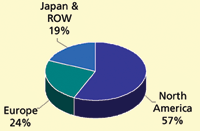Flash Chromatography
Flash chromatography is a type of preparative liquid chromatography commonly used in the separation of organic compounds. When purifying organic compounds, few techniques are as easy, inexpensive, and speedy as flash chromatography. Flash chromatography has become a popular method of normal phase separation through purification.
Flash chromatography is a type of preparative liquid chromatography commonly used in the separation of organic compounds. When purifying organic compounds, few techniques are as easy, inexpensive, and speedy as flash chromatography. Flash chromatography has become a popular method of normal phase separation through purification. While flash chromatography is typically a low-pressure technique, scientists are using vacuums or pumps at medium pressures to speed the separation process. The columns are packed with a silica adsorbent of defined particle size usually between 40–60 mm. Mobile phases with low viscosity require smaller particle sizes. While traditional flash chromatography required scientists to pack their own columns, many of them have turned to one-time use, pre-made flash cartridges.

Flash chromatography is used to scale up normal phase chemistries from thin layer chromatography. Demand for flash chromatography comes primarily from the pharmaceutical, biotech, petrochemical, and agrochemical industries. The pharmaceutical industry uses flash chromatography for a wide range of applications including purification of small compounds, peptides, and purification of natural products.
The overall market for flash chromatography continues to be strong, particularly in the life science market. Synthesis of organic compounds and peptides continue to fuel growth for flash systems. In fact, flash chromatography systems are expected to grow double-digits over the next five years. Flash is concentrated heavily in North America and Europe, which account for about 80% of the total market.
The foregoing data was extracted from Strategic Directions International Inc. Market Analysis and Perspectives (MAP) report entitled, Life Science Instrumentation: Supporting Systems Biology in Integrating Genomics, Proteomics, and Drug Discovery. For more information, contact Glenn Cudiamat, Vice President of Research Services, Strategic Directions International, Inc., 6242 Westchester Parkway, Suite 100, Los Angeles, CA 90045, tel. (310) 641-4982, fax (310) 641-8851, e-mail: cudiamat@strategic-directions.com or website: http://www.strategic-directions.com
Click here for printable version.

Regulatory Deadlines and Supply Chain Challenges Take Center Stage in Nitrosamine Discussion
April 10th 2025During an LCGC International peer exchange, Aloka Srinivasan, Mayank Bhanti, and Amber Burch discussed the regulatory deadlines and supply chain challenges that come with nitrosamine analysis.
Top Execs from Agilent, Waters, and Bruker Take the Stage at J.P. Morgan Healthcare Conference
January 16th 2025The 43rd Annual Healthcare J.P. Morgan Healthcare Conference kicked off in San Francisco earlier this week. Here’s what top executives from Agilent, Bruker, and Waters, discussed during the event.

.png&w=3840&q=75)

.png&w=3840&q=75)



.png&w=3840&q=75)



.png&w=3840&q=75)





